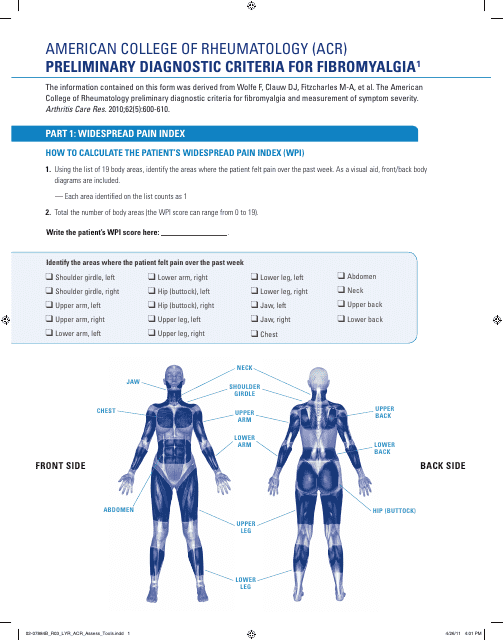Preliminary Diagnostic Criteria for Fibromyalgia
The Preliminary Diagnostic Criteria for Fibromyalgia is used for the diagnosis and research of fibromyalgia, a chronic pain disorder characterized by widespread musculoskeletal pain, fatigue, and tenderness in localized areas. This criteria was established to ensure consistency and accuracy in the identification and study of this condition. It includes specific guidelines and checklists that medical professionals can use to categorize and diagnose fibromyalgia in patients. This promotes standardization and contributes to a better understanding of this disorder.
The preliminary diagnostic criteria for Fibromyalgia are filed by the American College of Rheumatology (ACR). The ACR is a professional association of rheumatologists in the United States that is dedicated to the study of rheumatic diseases, including Fibromyalgia. The diagnostic criteria are periodically updated and released by the ACR to provide guidelines to help healthcare providers diagnose and treat these conditions more effectively.
FAQ
Q: What is Fibromyalgia?
A: Fibromyalgia is a chronic disorder that causes pervasive pain and tenderness throughout the body, often accompanied by fatigue and sleep, memory, and mood issues.
Q: What are the preliminary diagnostic criteria for Fibromyalgia?
A: Preliminary diagnostic criteria for Fibromyalgia typically include a history of widespread pain lasting more than three months, the presence of specific tender points on physical examination, as well as the elimination of other medical conditions that could cause similar symptoms.
Q: What causes Fibromyalgia?
A: The exact cause of Fibromyalgia is unknown, but it is thought to involve a variety of genetic, environmental, and psychological factors.
Q: How is the diagnosis of Fibromyalgia confirmed?
A: There's no specific test to diagnose Fibromyalgia. Instead, doctors make a diagnosis by considering a patient's symptoms and medical history, ruling out other disorders, and referring to the diagnostic criteria developed by the American College of Rheumatology.
Q: What are the treatment options for Fibromyalgia?
A: Fibromyalgia is often treated with a combination of medications, cognitive-behavioral therapies, and lifestyle changes aimed at managing symptoms and improving quality of life.
Q: Is Fibromyalgia a life-threatening disorder?
A: No, Fibromyalgia is not considered a life-threatening disorder. However, it can significantly impact the quality of life due to its chronic pain and other symptoms.
Q: Who is more likely to get Fibromyalgia?
A: While anyone can get Fibromyalgia, it's most commonly diagnosed in middle-aged women. However, men and children can also be diagnosed with this condition.
Q: How common is Fibromyalgia?
A: Fibromyalgia affects roughly 2-4% of the adult population globally. In the United States, it's estimated that 2% of the adult population is afflicted with the condition.
























